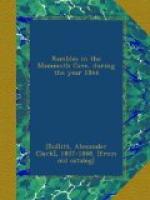“I have been thus minute in describing the mute witness from the days of other times, and the articles which were deposited within her earthen house. Of the race of people to whom she belonged when living, we know nothing; and as to conjecture, the reader who gathers from these pages this account, can judge of the matter as well as those who saw the remnant of mortality in the subterranean chambers in which she was entombed. The cause of the preservation of her body, dress and ornaments is no mystery. The dry atmosphere of the Cave, with the nitrate of lime, with which the earth that covers the bottom of these nether palaces is so highly impregnated, preserves animal flesh, and it will neither putrify nor decompose when confined to its unchanging action. Heat and moisture are both absent from the Cave, and it is these two agents, acting together, which produce both animal and vegetable decomposition and putrefaction.
“In the ornaments, etc., of this mute witness of ages gone, we have a record of olden time, from which, in the absence of a written record, we may draw some conclusions. In the various articles which constituted her ornaments, there were no metallic substances. In the make of her dress, there is no evidence of the use of any other machinery than the bone and horn needles. The beads are of a substance, of the use of which for such purposes, we have no account among people of whom we have any written record. She had no warlike arms. By what process the hair upon her head was cut short, or by what process the deer-skins were shorn, we have no means of conjecture. These articles afford us the same means of judging of the nation to which she belonged, and of their advances in the arts, that future generations will have in the exhumation of a tenant of one of our modern tombs, with the funeral shroud, etc. in a state of like preservation; with this difference, that with the present inhabitants of this section of the globe, but few articles of ornament are deposited with the body. The features of this ancient member of the human family much resembled those of a tall, handsome American woman. The forehead was high, and the head well formed.




